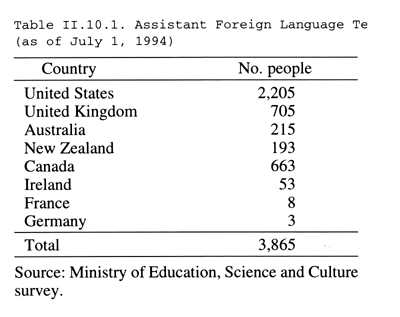| Home > Policy > White Paper, Notice, Announcement > White Paper > JAPANESE GOVERMENT POLICICIES IN EDUCATION, SCIENCE AND CULTURE 1994 > PART II Chapter 10 Section 2 2 | ||
Increased priority has been given to communication skills and international understanding in foreign language education under the new Courses of Study. For example, lower secondary schools may now add another hour to the time devoted to this subject area each week, bringing total class hours to four per week. At the upper secondary school level, the new subject of "oral/aural communication A, B, and C" has been introduced.
Under this program, which is administered by the Ministry of Education, Science and Culture in cooperation with the Ministry of Foreign Affairs, the Ministry of Home Affairs, and local governments, young people from other countries are invited to Japan to work as assistant foreign language teachers. The JET program offers a number of benefits for foreign language education, including opportunities for Japanese students to learn foreign languages directly from native speakers. The program has been extremely effective in improving students' communication skills, and efforts are now being made to expand the program ( Table II.10.1 ).

In fiscal 1994 the number of lower and upper secondary school English teachers receiving training within Japan was increased to 600, compared with 200 in fiscal 1993. There was also an increase in the number of teachers sent to the United States and the United Kingdom for two-month courses (190) and six-month courses (58), while the number taking the 12-month course was expanded from 26 to 30. In addition, the Japanese Government Scholarship Program is being implemented for students in the foreign language teacher training courses of national universities. The number of places in this program has been increased from 106 to 116.
Subsidies are provided for the improvement of language laboratories and other educational equipment used in lower and upper secondary schools.
There are arguments both for and against foreign language education in elementary schools, and the concept needs to be studied carefully from a wide range of perspectives. Practical research is being carried out at pilot schools.
To adapt effectively to internationalization, it is also necessary to focus on diversified foreign language education in languages other than English. Since fiscal 1991 the Ministry of Education, Science and Culture has been conducting research at pilot schools for research and surveys on diversified foreign language education in upper secondary schools. Foreign language education in universities and junior colleges takes a variety of forms, including education and research in foreign language faculties. There has been criticism, however, that the educational content and teaching methods tend to overemphasize reading skills, and universities and junior colleges are now working to improve their educational content and teaching methods in various ways. With the cooperation of foreign governments, German and French teachers in universities and other institutions of higher education are being sent overseas to participate in foreign language education seminars. In fiscal 1994, 33 teachers were sent overseas. A survey of foreign language education in universities and other institutions of higher education reveals that many have established subjects in a variety of languages in recent years. In fiscal 1992 approximately 70 languages were being taught.
| Back to Top | MEXT HOME |